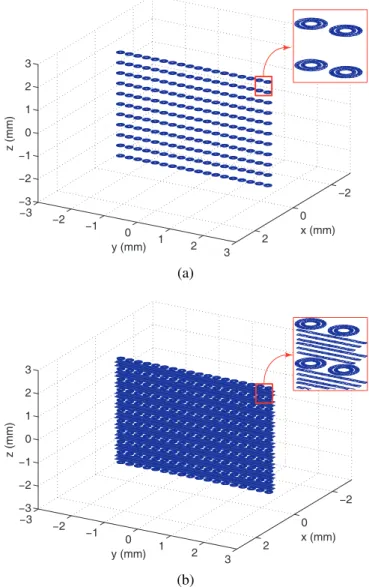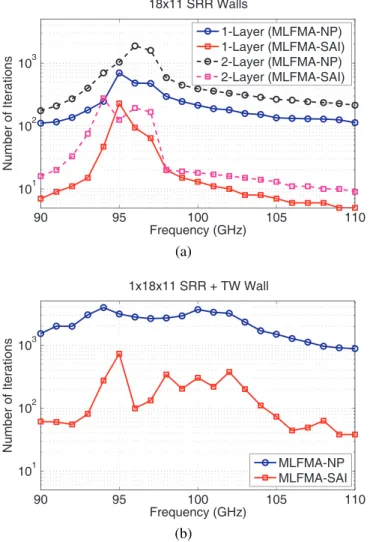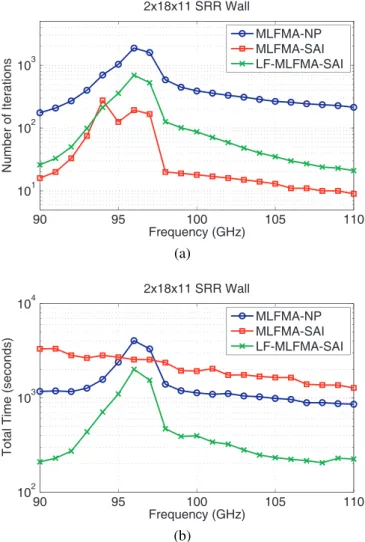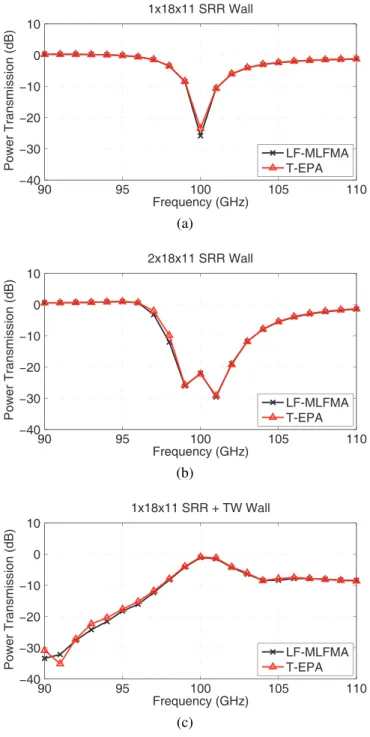Efficient Surface Integral Equation Methods for
the Analysis of Complex Metamaterial Structures
Pasi Yl¨a-Oijala
#1, ¨
Ozg¨ur Erg¨ul
∗, Levent G¨urel
∗2, Matti Taskinen
##Department of Radio Science and Engineering, Helsinki University of Technology, Finland ∗Computational Electromagnetics Research Center (BiLCEM), Bilkent University, Turkey
1pasi.yla-oijala@tkk.fi, 2lgurel@ee.bilkent.edu.tr
Abstract—Two approaches, the multilevel fast multipole
al-gorithm with sparse approximate inverse preconditioner and the surface equivalence principle algorithm, are applied to analyze complex three-dimensional metamaterial structures. The efficiency and performance of these methods are studied and discussed.
I. INTRODUCTION
Metamaterials are artificial structures that are composed by periodically arranging unit cells, such as split ring res-onators (SRRs), thin wires (TWs) or other more complex components. Due to resonance effects and strong interactions between the cells, a metamaterial structure can have elec-tromagnetic properties that are not present in its individual components [1].
Developing efficient computational methods for complex three-dimensional (3-D) metamaterial structures is challenging and many problems that do not occur in the case of conven-tional materials must be resolved. For example, due to the res-onant nature of the unit cells, matrix equations obtained from the discretization of metamaterial structures can be very ill-conditioned, essentially preventing effective iterative solutions at certain frequencies. In addition, metamaterials are typical examples of multi-scale problems since they usually involve very small components with respect to wavelength, and those components must be modelled accurately in order to analyze the electromagnetic response of the entire structure. On the other hand, realistic simulations of metamaterials contain large numbers of unit cells [1], and the entire structure can be several wavelengths in size.
In this paper, surface integral equation methods are applied for the analysis of finite metamaterial structures without pe-riodicity assumptions. In general, surface integral equations allow versatile and accurate geometrical modelling of the structures. We present two different approaches for the effi-cient simulation of metamaterials. In the first approach, an ordinary multilevel fast multipole algorithm (MLFMA) and a low-frequency MLFMA (LF-MLFMA) [2],[3] are employed. Iterative solutions are also accelerated by the sparse approxi-mate inverse (SAI) preconditioner [4]. In the second approach, we employ a domain decomposition method utilizing surface equivalence principle [5],[6], i.e., the tangential equivalence principle algorithm (T-EPA) [7]. Both approaches are used to solve electromagnetic problems involving various metamate-rial walls composed of SRRs and TWs, as depicted in Fig. 1.
−2 0 2 −3 −2 −1 0 1 2 3 −3 −2 −1 0 1 2 3 z (mm) x (mm) y (mm) (a) −2 0 2 −3 −2 −1 0 1 2 3 −3 −2 −1 0 1 2 3 x (mm) y (mm) z (mm) (b)
Fig. 1. Metamaterial walls involving (a) SRRs and (b) SRRs combined with TWs.
II. SURFACEINTEGRALEQUATIONFORMULATION
Consider a metamaterial structure involving a finite number of perfectly-conducting objects (unit cells) Dp, p = 1, . . . , P , in a homogeneous background D0 with constant electric
Dp with surface Sp can have an arbitrary shape and can be located arbitrarily. SRRs and TWs are modelled by open surfaces with zero thickness. Time-harmonic (e−iωt) incident electromagnetic fields exists in D0.
Let Jp denote the induced electric surface current density on the surface Sp, and Lqp denote the electric-field integral equation (EFIE) operator with source point on Sp and obser-vation point on Sq. EFIEs for P objects can be expressed as L11 L12 . . . L1P L21 L22 . . . L2P .. . ... . .. ... LP 1 LP 2 . . . LP P · J1 J2 .. . JP = (Ei1)tan (Ei2)tan .. . (EiP)tan , (1)
where the tangential component of the incident electric field is on the right-hand side of the equation. By the discretization of (1) with the Rao-Wilton-Glisson (RWG) functions [8] defined on planar triangles and Galerkin’s method, we obtain dense matrix equations to solve for the induced currents Jp. On the other hand, discretizations of metamaterial structures usually lead to large matrix equations, which cannot be solved directly. Therefore, more advanced techniques are required to solve metamaterial problems.
III. MULTILEVELFASTMULTIPOLEALGORITHM AND
PRECONDITIONING
The computational cost of the methods based on the surface integral equations can be essentially reduced with MLFMA [2]. In this method, the basic idea is to divide the unknowns into groups (clusters) based on their locations in space and to calculate the interactions of clusters as large as possible in a multilevel scheme rather than calculating the interactions of the individual elements. In order to calculate the interactions efficiently in a group-by-group manner,
1) the homogeneous-space Green’s function is factorized in a series of multipoles,
2) interactions between clusters are expressed as sequences of aggregation, translation, and disaggregation stages, 3) multipoles are converted into plane waves to diagonalize
the interactions of clusters.
By employing MLFMA, a matrix-vector multiplication involv-ing an N × N dense matrix can be performed in O(N log N ) time using O(N log N ) memory.
Although MLFMA accelerates the matrix-vector multiplica-tions, this method operates on the original matrix equation and thus the slow convergence of the iterative solution can result in a major bottleneck. As a remedy, the conditioning of the matrix equation can be improved by using a proper preconditioner. On the other hand, finding an efficient and robust preconditioner is a problem, particularly in the case of complex metamaterial structures composed of open perfectly-conducting objects, because of two reasons. Firstly, the formulation is based on EFIE, which is known to yield ill-conditioned matrix equa-tions. Secondly, at certain frequencies, metamaterial structures have strong resonant behavior, significantly increasing the
conditioning number of the matrix. Additional problems arise with MLFMA, where the preconditioner has to be built with only a small portion of the matrix. In this paper, we use the SAI preconditioner [4], which effectively reduces the iteration counts for open surfaces formulated with EFIE.
IV. LOW-FREQUENCYMULTILEVELFASTMULTIPOLE
ALGORITHM
MLFMA combined with the SAI preconditioner is an ef-fective solver for electromagnetics problems discretized with large numbers of unknowns. In the case of metamaterial structures, however, the efficiency of MLFMA may deteriorate significantly. This is because metamaterials involve small details that must be discretized with small triangles compared to the wavelength. On the other hand, the size of the clusters in MLFMA cannot be smaller than a quarter wavelength since the plane wave expansion becomes invalid for short distances. As a result, when an ordinary MLFMA is applied on metamaterial problems, the lowest-level clusters may involve many triangles and RWG functions. This significantly increases the processing time and memory required for the near-field interactions, which must be calculated directly. Even the complexity of the MLFMA implementation can be more than O(N log N ) due to excessively large numbers of the near-field interactions.
When MLFMA is inefficient, we employ LF-MLFMA for the solution of metamaterial problems. In LF-MLFMA, the Green’s function is factorized in a series of multipoles, but the multipoles are not converted into plane waves. Then, ag-gregation, translation, and disaggregation stages are performed by directly using the multipoles. This way, the cluster size is not restricted, and we are able to divide the object into subclusters, which can be much smaller than the quarter wave-length. For metamaterial structures with dimensions of several wavelengths, the complexity of LF-MLFMA is O(N log N ).
V. SURFACEEQUIVALENCEPRINCIPLEALGORITHM
Another approach to solve an ill-conditioning problem that is due to a resonating metamaterial structure is to reformulate the problem into a better-conditioned one by utilizing a do-main decomposition method based on the surface equivalence principle [5]. In an equivalence principle algorithm (EPA), the objects are grouped and the groups are enclosed by equivalence surfaces. Then, the surface equivalence principle operators are used to calculate the fields scattered by the equivalence surfaces and the interactions between them.
Assume that the unit cells Dpcan be divided into L disjoint groups bounded by equivalence surfaces Rl, l = 1, . . . , L. The unknown equivalent electric and magnetic currents Jsl =
ˆ
90 95 100 105 110 101 102 103 Frequency (GHz) Number of Iterations 18x11 SRR Walls 1-Layer (MLFMA-NP) 1-Layer (MLFMA-SAI) 2-Layer (MLFMA-NP) 2-Layer (MLFMA-SAI) (a) 90 95 100 105 110 101 102 103 Frequency (GHz) Number of Iterations 1x18x11 SRR + TW Wall MLFMA-NP MLFMA-SAI (b)
Fig. 2. Number of GMRES iterations (10−3residual error) for the solution
of scattering problems involving (a) 1-layer and 2-layer SRR walls and (b) a 1-layer CMM wall.
equations that can expressed as [7] I −S11T12 . . . −S11T1L −S22T21 I . . . −S22T2L .. . . .. ... −SLLTL1 . . . I Us1 Us2 .. . UsL = S11Ui1 S22Ui2 .. . SLLUiL , (2) where Us/il = J s/i l Ms/il = " ˆ nl× Hs/i − ˆnl× Es/i # , (3)
I is the identity operator, and Sll and Tlk (l 6= k) are scattering and translation operators. Here Es and Hs are the scattered fields on Rl due to the currents on Dp within Rl.
Equation (2) is again discretized with the RWG functions using a Galerkin’s scheme. Once the coefficients of the equiv-alent currents Jsl and Msl are obtained by solving the matrix equation due to (2), the scattered electric and magnetic fields can be computed at any point outside the equivalence surfaces.
90 95 100 105 110
102 103 104
Frequency (GHz)
Total Time (seconds)
18x11 SRR Walls 1-Layer (MLFMA-NP) 1-Layer (MLFMA-SAI) 2-Layer (MLFMA-NP) 2-Layer (MLFMA-SAI) (a) 90 95 100 105 110 102 103 104 Frequency (GHz)
Total Time (seconds)
1x18x11 SRR + TW Wall
MLFMA-NP MLFMA-SAI
(b)
Fig. 3. Total processing time for the solution of scattering problems involving (a) 1-layer and 2-layer SRR walls and (b) a 1-layer CMM wall.
EPA has been demonstrated to be an efficient method for complex multi-scale problems [5],[6]. Using EPA, the original problem with a lot of complexity can be divided into sub-problems and the solution of one region can be isolated from another. Consequently, EPA usually improves the conditioning of the matrix and reduces the number of unknowns.
In the cases where the same structure is repeated several times, EPA has an additional benefit. Namely, by choosing the equivalence surfaces so that they are identical and they contain an identical portion of the original structure, the same scattering operator can be used many times without a need to recalculate it. This property can be utilized to increase the efficiency and memory consumption of the algorithm in the case of periodic metamaterial structures composed of identical unit cells.
The calculations of this paper are based on the recently developed T-EPA [7]. This algorithm is shown to have better solution accuracy with coarser mesh density than the original EPA developed in [5].
90 95 100 105 110 101 102 103 Frequency (GHz) Number of Iterations 2x18x11 SRR Wall MLFMA-NP MLFMA-SAI LF-MLFMA-SAI (a) 90 95 100 105 110 102 103 104 Frequency (GHz)
Total Time (seconds)
2x18x11 SRR Wall
MLFMA-NP MLFMA-SAI LF-MLFMA-SAI
(b)
Fig. 4. (a) Number of GMRES iterations (10−3residual error) and (b) total
processing time for the solution of scattering problems involving a 2-layer SRR wall.
VI. NUMERICALEXAMPLES
As numerical examples, we consider the solution of meta-material structures involving n × 18 × 11 SRRs and TWs. For example, Fig. 1(a) depicts a 1-layer SRR wall, which is constructed by periodically arranging 18 × 11 SRRs. In addi-tion, Fig. 1(b) depicts a composite metamaterial (CMM) wall obtained by combining the SRR array in Fig. 1(a) with TWs. Geometrical details, including the dimensions of the SRRs and TWs, as well as the periodicity in each direction, are given in [9]. The structures are embedded into a homogeneous host medium with a relative permittivity of 4.8. The incident field is generated by a Hertzian dipole located at x = −1.2 mm. For numerical solutions, problems are discretized with the RWG functions using a Galerkin scheme. The number of unknowns is in the 16,000–32,000 and 9,000–11,000 ranges for the solutions with MLFMA and T-EPA, respectively. Fewer unknowns are required for T-EPA since the currents on the equivalence surfaces are usually much smoother than those on the original surfaces of the metamaterials. All iterative solutions are performed by using the generalized minimal
90 95 100 105 110 100 101 102 103 Frequency (GHz) Number of Iterations T-EPA 1x18x11 SRR Wall 2x18x11 SRR Wall 1x18x11 SRR + TW Wall
Fig. 5. Number of GMRES iterations (10−3residual error) for the solution
of metamaterial problems with T-EPA.
residual (GMRES) method without restarting. The relative residual error for convergence is set to 10−3. Matrix elements in MLFMA and LF-MLFMA are computed with maximum 1% error. In T-EPA, SRR and CMM arrays are divided into 11 equal groups in the z direction and the groups are enclosed by rectangular equivalence surfaces.
Figs. 2 and 3 present the number of iterations and the total processing time, respectively, as a function of frequency for the solution of metamaterial problems by a 3-level MLFMA. In addition to 1-layer SRR and CMM walls in Fig. 1, we consider a two-layer SRR wall, which is obtained by stacking two 18 × 11 arrays. Fig. 2 shows that the number of iterations is reduced significantly by employing the SAI preconditioner, compared to the no-preconditioner (NP) case. We also note numerical resonances around 95 GHz, where the iterative convergence is difficult even with the SAI preconditioner. On the other hand, Fig. 3 shows that the SAI preconditioner accelerates only the solution of the 1-layer CMM structure. For the SRR arrays, the total time, which includes the near-field interactions and the setup of SAI in addition to the iterative solution part, does not decrease simply by reducing the iteration counts via SAI. In fact, for those problems, the gain in the solution time provided by SAI is wasted by the additional costs due to the setup of this preconditioner.
As described in Section IV, LF-MLFMA can be used to accelerate the solution of metamaterial problems. As an example, Fig. 4 presents the solution of problems involving the 2-layer SRR wall. In addition to MLFMA solutions, we consider a 4-level LF-MLFMA that is accelerated with SAI. As depicted in Fig. 4(a), the numbers of iterations are higher with LF-MLFMA and SAI than with MLFMA and SAI. This is because the number of matrix elements used to construct the preconditioner is smaller in LF-MLFMA, compared to MLFMA. Nevertheless, as depicted in Fig. 4(b), LF-MLFMA is more efficient than MLFMA due to the significant reduction in processing time for the calculation of the near-field inter-actions.
90 95 100 105 110 −40 −30 −20 −10 0 10 Frequency (GHz) Power Transmission (dB ) 1x18x11 SRR Wall LF-MLFMA T-EPA (a) 90 95 100 105 110 −40 −30 −20 −10 0 10 Frequency (GHz) Power Transmission (dB ) 2x18x11 SRR Wall LF-MLFMA T-EPA (b) 90 95 100 105 110 −40 −30 −20 −10 0 10 Frequency (GHz) Power Transmission (dB ) 1x18x11 SRR + TW Wall LF-MLFMA T-EPA (c)
Fig. 6. Power transmission (at x = 1.2 mm) for (a) a 1-layer SRR wall, (b) a 2-layer SRR wall, and (c) a 1-layer CMM wall as a function frequency.
metamaterial problems using T-EPA without preconditioning. We note that the number of iterations is very low since T-EPA replaces the original ill-conditioned problems with the new well-conditioned ones. On the other hand, the scattering and translation operators in T-EPA, namely, Sll and Tlk, are composed of several surface integral operators. Therefore, matrix equations solved in T-EPA are much more complicated than those in MLFMA solutions of EFIE. T-EPA requires also additional meshing.
In T-EPA, the total processing time is directly related to the number of iterations, since no preconditioning is used. The
properties of T-EPA, including the total processing time, may however depend much on the construction of the equivalent surfaces Rl [10]. For example, by increasing the number of the equivalence surfaces, both the solution accuracy and convergence of the iterative solution decreases.
Finally, Fig. 6 presents the power transmission through the SRR and CMM walls as a function of frequency. The total power is divided by the incident power at x = 1.2 mm. We observe that transmission values obtained with T-EPA and LF-MLFMA agree well with each other. The SRR walls are transparent at ordinary frequencies, but they become opaque and the power transmission drops around 100 GHz (resonance frequency). On the other hand, the CMM wall is opaque and prevents transmission at ordinary frequencies, but it becomes transparent around the resonance frequency. These results are in agreement with the experimental observations in [11].
VII. CONCLUSION
We present two approaches based on surface integral equa-tions for the solution of electromagnetics problems involving realistic metamaterial structures. In the first approach, matrix equations obtained with EFIE are solved by MLFMA or LF-MLFMA combined with the SAI preconditioner. In the second approach, T-EPA is used to construct well-conditioned matrix equations that can be solved efficiently by iterative methods. It is demonstrated that these two approaches allow fast and accurate simulations of complex metamaterial structures.
REFERENCES
[1] M. Lapine and S. Tretyakov, “Contemporary notes on metamaterials,”
IET Microw. Antennas Propag., vol. 1, no. 1, pp. 3–11, 2007.
[2] W. C. Chew, J.-M. Jin, E. Michielssen, and J. Song, Fast and Efficient
Algorithms in Computational Electromagnetics, Artech House, Boston,
2001.
[3] L. J. Jiang and W. C. Chew, “A mixed-form fast multipole algorithm,”
IEEE Trans. Antennas Propagat., vol. 53, no. 12, pp. 4145–4156,
Dec. 2005.
[4] T. Malas and L. G¨urel, “Accelerating the multilevel fast multipole algorithm with the sparse-approximate-inverse (SAI) preconditioning,”
SIAM J. Sci. Comput., in press.
[5] M.-K. Li and W. C. Chew, “Wave-field interaction with complex structures using equivalence principle algorithm,” IEEE Trans. Antennas
Propagat., vol. 55, no. 1, pp. 130–138, Jan. 2007.
[6] M.-K. Li and W. C. Chew, “Multiscale simulation of complex struc-tures using equivalence principle algorithm with high-order field point sampling scheme,” IEEE Trans. Antennas Propagat., vol. 56, no. 8, pp. 2389–2397, Aug. 2008.
[7] P. Yl¨a-Oijala and M. Taskinen, “Electromagnetic scattering by large and complex structures with surface equivalence principle algorithm,” Waves
in Random and Complex Media, in press.
[8] S. M. Rao, D. R. Wilton, and A. W. Glisson, “Electromagnetic scatter-ing by surfaces of arbitrary shape,” IEEE Trans. Antennas Propagat., vol. AP-30, no. 3, pp. 409–418, May 1982.
[9] L. G¨urel, ¨O. Erg¨ul, A. ¨Unal, and T. Malas, “Fast and accurate analysis of large metamaterial structures using the multilevel fast multipole algorithm,” IEEE Trans. Antennas Propagat., submitted for publication. [10] P. Yl¨a-Oijala and M. Taskinen, “Solving electromagnetic scattering by multiple targets with surface equivalance principle algorithm,” The Third
European Conference on Antennas and Propagation (EuCAP 2009),
Berlin, Germany.
[11] M. Gokkavas, K. G¨uven, I. Bulu, K. Aydın, R. S. Penciu, M. Kafesaki, C. M. Soukoulis, and E. ¨Ozbay, “Experimental demonstration of a left-handed metamaterial operating at 100 GHz,” Phys. Rev. B., vol. 73, no. 19, pp. 193103-1–193103-4, May 2006.



